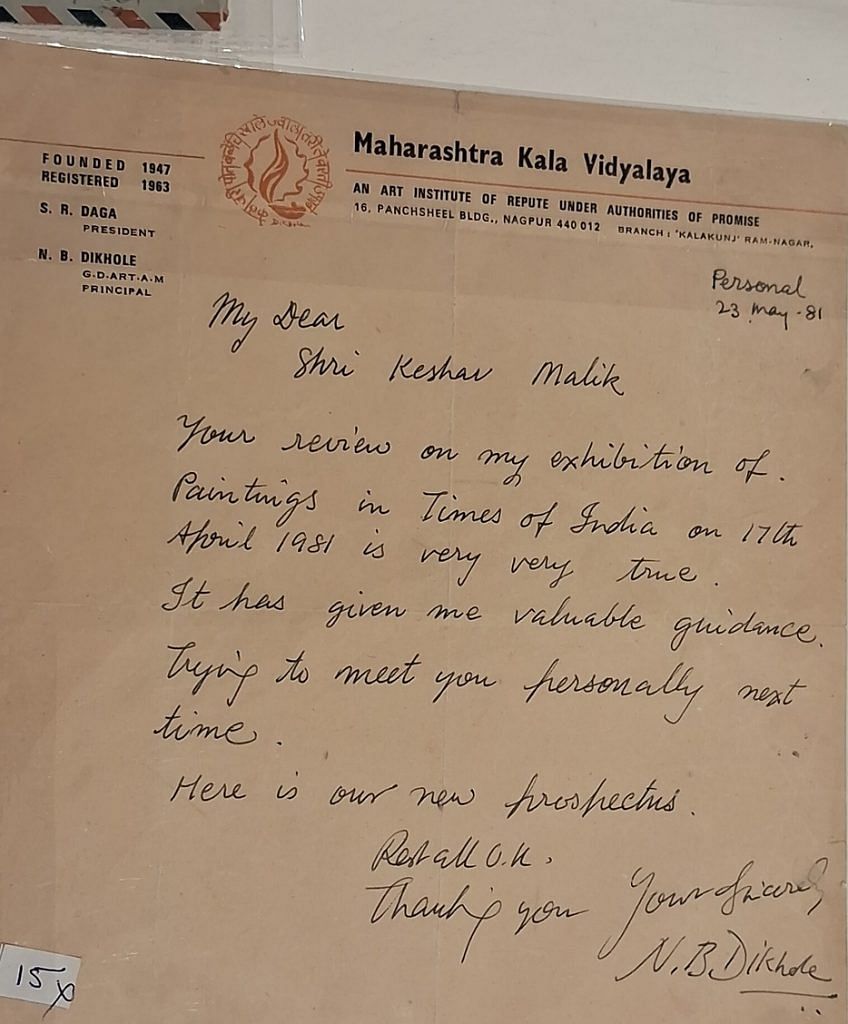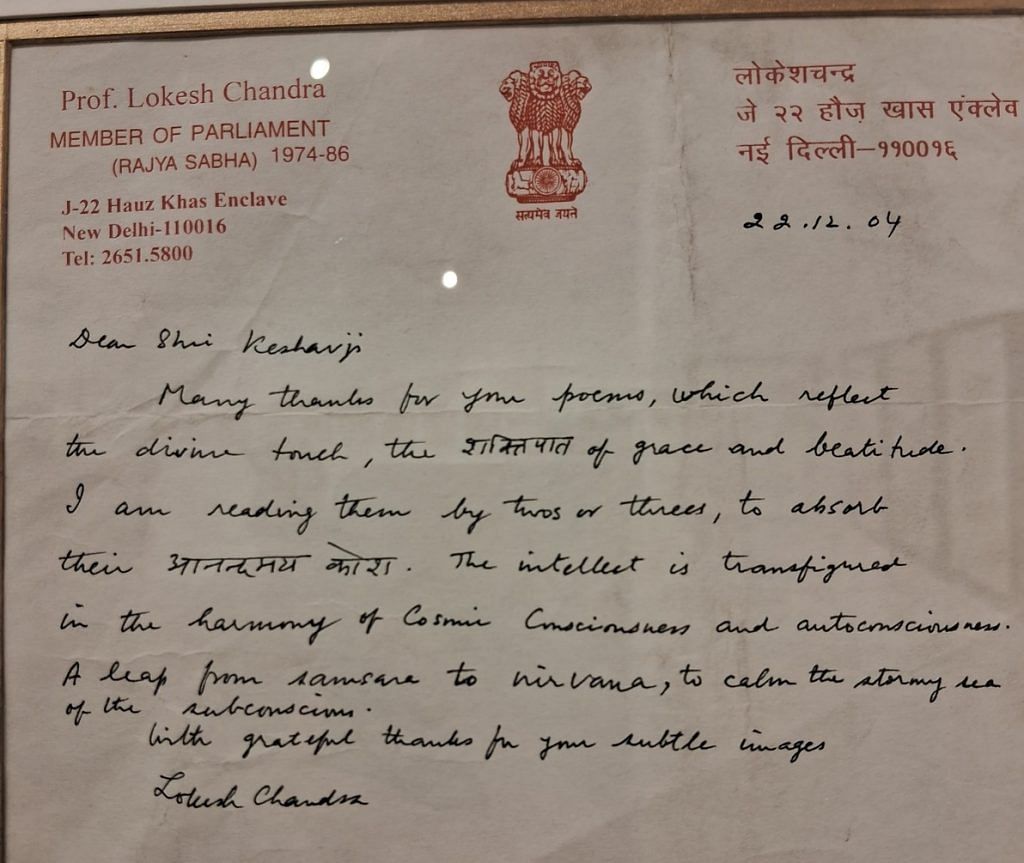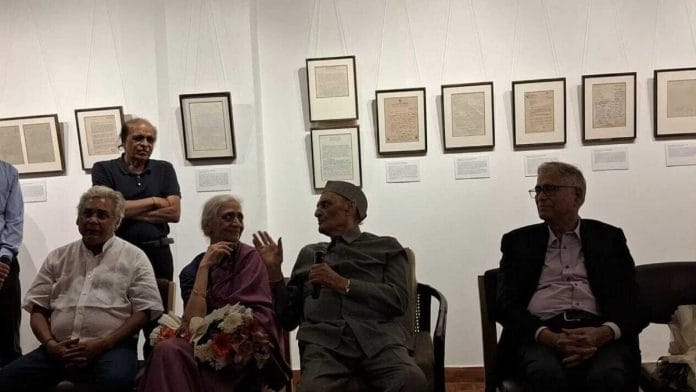New Delhi: A showcase of handwritten letters by artists and publishers is challenging the conventional assumption that the relationship between art critics and artists is transactional, strained and awkward. A sense of warmth and friendship filled the exhibition hall at India International Centre as grey-haired attendees read letters addressed to poet and art critic Keshav Malik.
‘The Written Canvas: Letters to Keshav Malik from Artists and Thinkers’ reflects the reverence, friendship, and collaboration between Malik and artists such as MF Husain, Nissim Ezekiel, and Jogen Chowdhury. Organised by Art Konsult and inaugurated on 4 November by former Rajya Sabha member Karan Singh, it is on display till 9 November and celebrates Malik’s birth centenary.
A Padma Shri awardee and critic for The Hindustan Times and Times of India, Keshav Malik cultivated a companionship with artists through his “perceptive and as always eloquent reviews”, wrote painter Jehangir Sabavala in one of the 300 displayed letters.
“Personal letters have also been a source of social and cultural history, reflecting the concerns, ideas, and beliefs that shaped the events that happened at that particular time and place,” said Usha Malik, Keshav Malik’s wife, according to the exhibition catalogue. “They are also a reflection of the values, the depth of understanding and biases of the individuals concerned. The exhibits here are a testimony to that.”
A letter by painter NB Dikhole showed how deeply artists respected Malik. “Your review of my exhibition of painting in Times of India on 17th April 1981 is very true. It has given me valuable guidance.”

Not everyone received such adoration, though. In his written correspondence with Malik’s wife, artist Prafulla Mohanti recalled being on the receiving end of violent attacks. “A couple of days ago, I had a very nasty experience. [Odissi dancer-musician duo] Sanjukta Panigrahi and Raghunath Panigrahi came to my house and assaulted me. Raghunath Panigrahi attacked me with a knife and there are a couple of cuts on my face. They were angry because I had written an article giving a critical assessment of their performance at a recent cultural function in Bhubaneshwar.”
On 4 November, the exhibition’s inaugural day and Keshav Malik’s hundredth birth anniversary, Karan Singh recalled his conversations with the poet-cum-art critic. “We used to talk about Kashmir sometimes, the beauty of Kashmir because we were both from there. He was very quiet, and he had a strong energy.”
Describing himself as an “avid letter writer”, Singh went on to express disappointment at the waning practice of letter writing. “Mainey kalam nikali aur syahi nahi mili (I took out a pen to write and didn’t find the ink) …Nuances that come through the written word, all the subtleties [are now non-existent]. Likhne mein jo nazakat hoti thi, woh gayab hogayi, abb machine likhti hain (the delicacy of writing has disappeared, now machines write everything)”.
The unique exhibit features Malik’s correspondences with renowned Indian artists and thinkers such as Biren De, Gayatri Singha, FN Souza, Harivansh Rai Bachchan, as well as Western ones such as Elisabeth Buschmann, Robert Penn Warren, and Lee Waisler.
Also read:
All-encompassing legacy
Malik’s affiliations extended beyond arts and literature, though. He served as a personal assistant to India’s first Prime Minister, Jawaharlal Nehru from 1947 to 1948, before becoming a critic for Hindustan Times (1960-1972) and Times of India (1975-2000).
Committed to nurturing the arts, he co-founded the Poetry Society of India and served as an executive board member of the Lalit Kala Akademi in New Delhi.
“His work not only explored the formal aspects of art but also delved into its philosophical and social dimensions, establishing him as a thoughtful and authoritative voice,” said Siddhartha Tagore, owner of Art Konsult and a friend of Malik.
He went on to describe Malik as gentle and helpful. “He was of a different kind. You don’t get to see that kind of people anymore…young artists wouldn’t even take an appointment. They would just go to his house and he would make tea and coffee for them, those days things were different.” Malik’s writing was lyrical and tactile, Tagore added. “The main thing is that he was a poet and an artist, which gave character to his writing. You see all these qualities [in his work].”
Keshav Malik published 18 volumes of poetry, such as The Lake Surface and Other Poems, Storm Warning, and Between Nobodies and Stars. He also edited six anthologies of English translations of Indian poetry.
In his letter to Malik, prominent scholar and Rajya Sabha MP Lokesh Chandra described the former’s poetry as full of “grace and beatitude”. “Many thanks for your poems, which reflect the divine touch…The intellect is transfigured in the harmony of cosmic consciousness and auto consciousness. A leap from samsara to nirvana, to calm the stormy sea of the subconscious.”

American poet Robert Warren also praised Malik’s work in a 1962 letter. “The books for me, at least, have true poetry, an intellectual grasp and emotional gravity, and a use of language that, at its best, is strong, and strongly your own.”
According to Gaurav Kumar, an art curator for the event, Keshav Malik “never polluted his writing, and expressed his suggestions from a neutral perspective…he challenged artists through his reviews, with solutions and suggestions.”
(Edited by Zoya Bhatti)






